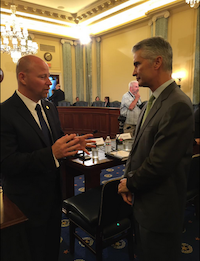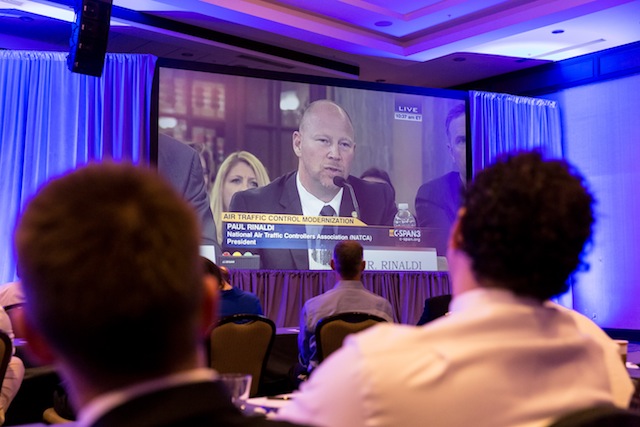
May 21, 2015 // NATCA President Paul Rinaldi Testifies before Senate Committee to Advocate for Stable, Predictable Funding for the NAS
 |
| Rinaldi (left) with fellow hearing panelist Jeff Smisek, President and CEO, United Airlines. |
NATCA President Paul Rinaldi testified before the Senate Commerce, Science, and Transportation Committee on Tuesday, May 19, to discuss the need for a stable, predictable funding stream for the National Airspace System (NAS). Rinaldi’s testimony outlined some of the existing problems at the FAA, including the negative effects unstable funding has on the NAS.
“Currently, we face many challenges in responding to the given problems of an unstable, unpredictable funding stream, including but not limited to financing long-term projects such as NextGen, the inability to grow the National Airspace System for new users – the UAV community and commercial space – and the inability to modernize our aging infrastructure,” said Rinaldi.
Rinaldi also made clear that although change is needed, NATCA opposes any change that would create a private, for-profit entity to oversee air traffic control services.
“We understand that addressing the stop-and-go funding problems will lead to an examination of a potential structural change for the FAA,” said Rinaldi. “We believe it’s time for a structural change. The current system is not dynamic enough to address the needs of air traffic control operations in the future. But any such change or reform must be carefully examined to prevent any unintended consequences from negatively affecting the safety and the efficiency of our National Airspace System. Every stakeholder in the National Airspace System should work together to make sure the United States continues to be the global leader in aviation.”
He added: “We need a structure that will allow us to grow aviation in this country and not shrink it. We need a structure that will allow us to modernize our facilities, equipment, procedures, and technology in a realistic timeframe. We need a structure that will give us the competitive edge to ensure our future leadership in the global aviation community.”
Read Rinaldi’s full testimony here.
To watch the entire hearing, please click here.
Full transcript of Rinaldi’s opening statement:
Mr. Chairman and Senators of the Committee, thank you for the opportunity to testify in front of you today at this important hearing to discuss the future of our aviation system. We all have a stake in the National Airspace System. It’s an economic engine for this country, contributes $1.5 trillion dollars to the Gross Domestic Product, and provides over 12 million American jobs.
We invented aviation in this country. It’s an American tradition. And over the last 100 years, we have dreamed, innovated, and implemented the unbelievable in aviation. Currently, we run the largest, safest, most efficient, most complex, most diverse system in the world. Our system is incomparable, unequaled, and unrivaled by any other country.
For example, the next-largest airspace system in the world to the United States is Canada. They run roughly 12 million operations a year. On average, the Unites States airspace system runs over 132 million operations a year. The United States system and the FAA are considered the gold standard in the world aviation community. And yet the reality is, in order to keep that honor, a change is needed.
Currently, we face many challenges in responding to the given problems of an unstable, unpredictable funding stream, including but not limited to the inability to finance long-term projects such as NextGen, the inability to grow the National Airspace System for new users, the UAV community and commercial space, the inability to modernize our aging infrastructure. Currently, our 20 en route centers throughout the country are over 50 years old with no plan of replacing them. Currently we are struggling to maintain our proper resources and staffing at our busiest air traffic control facilities. Our certified air traffic controllers are at an all-time low.
The upcoming FAA reauthorization bill must address the lack of a predictable, stable funding stream for our continuous, hyper-critical, safety aviation operation. We understand that addressing the stop and go funding problems will lead to an examination of a potential structural change for the FAA. We believe it’s time for a structural change. The current system is not dynamic enough to address the needs of air traffic control operations in the future. But any such change or reform must be carefully examined to prevent the unintended consequences of negatively affecting the safety and the efficiency of our National Airspace System. Every stakeholder in the National Airspace System should work together to make sure the United States continues to be the global leader in aviation.
Any reform must address the safety and efficiency of the National Airspace System. It must be mission-driven. It must have a process which provides a stable, predictable funding system to adequately support air traffic control services, staffing, hiring, training, and long-term projects such as NextGen.
 |
| NATCA members viewing Rinaldi giving testimony from NATCA in Washington 2015. |
Any change must allow for continued growth of our aviation system. Any change must be dynamic. The aviation system must continue to provide all services to all segments of the aviation community. Any change we make needs to be precision-like so that we don’t interrupt the day to day operation of the National Airspace System.
Our National Airspace System is an American treasure. Aviation is a uniquely American tradition. We cannot continue to shortchange it. We are still currently recovering from the sequestration cuts of 2013. Another round of cuts that are scheduled to take place this year will shrink our country’s aviation footprint forever. We need to make appropriate changes to secure a stable funding stream for aviation. We need to establish a proper governance structure for our National Airspace System; a structure that is not laden with bureaucratic lines of business, a structure that is not burdened or marred with bureaucratic process. We need a dynamic structure that is nimble. We need a structure that will allow us to grow aviation in this country and not shrink it. We need a structure that will allow us to modernize our facilities, equipment, procedures, and technology in a realistic timeframe. We need a structure that will give us the competitive edge to ensure our future leadership in the global aviation community.
Mr. Chairman, I thank you for the opportunity to testify in front of you today. I look forward to answering any of your questions or any questions the Senators may have. Thank you.

